The Best Things to do in East Iceland (2025 Guide)
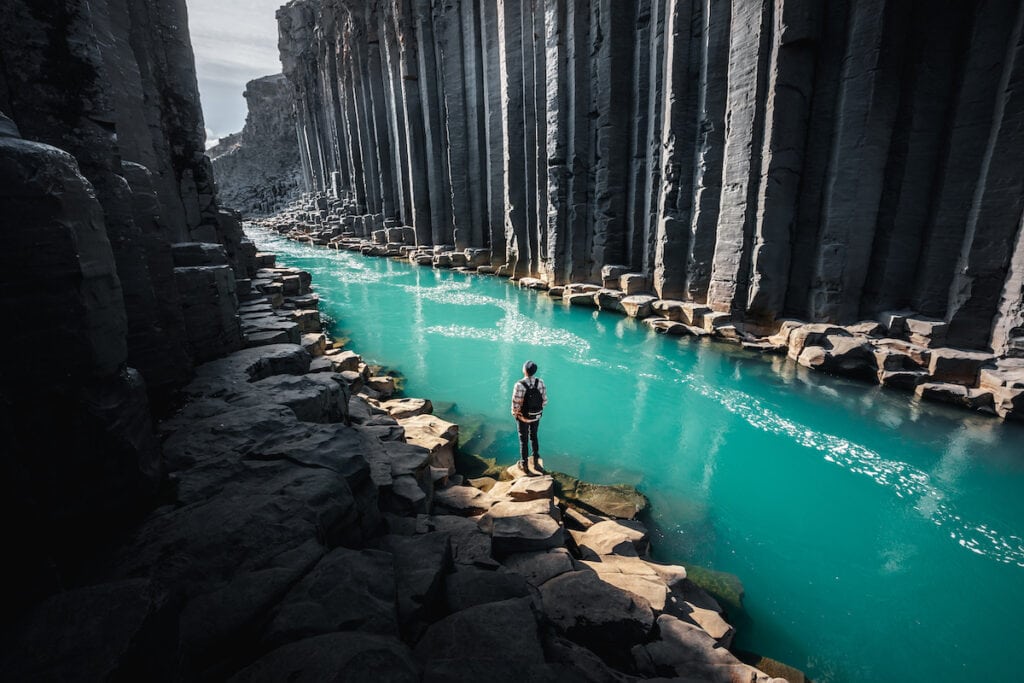
Affiliate Disclosure: This post on attractions in the East of Iceland may contain affiliate links. If you click a link and make a purchase, I may receive a small commission at no cost to you. All opinions are entirely my own.

HI, I’M TARA!
I fell crazy in love with Iceland on my first trip back in 2016 and have been creating guides to help others discover this extraordinary destination ever since!
INTRODUCTION
Many people experience East Iceland quite quickly while driving the epic Ring Road or as passengers on multi-day tours. While East Iceland may not initially seem as compelling as the jaw-dropping waterfalls and glaciers of South Iceland or the unparalleled whale-watching opportunities of the North, its attractions can absolutely hold their own!
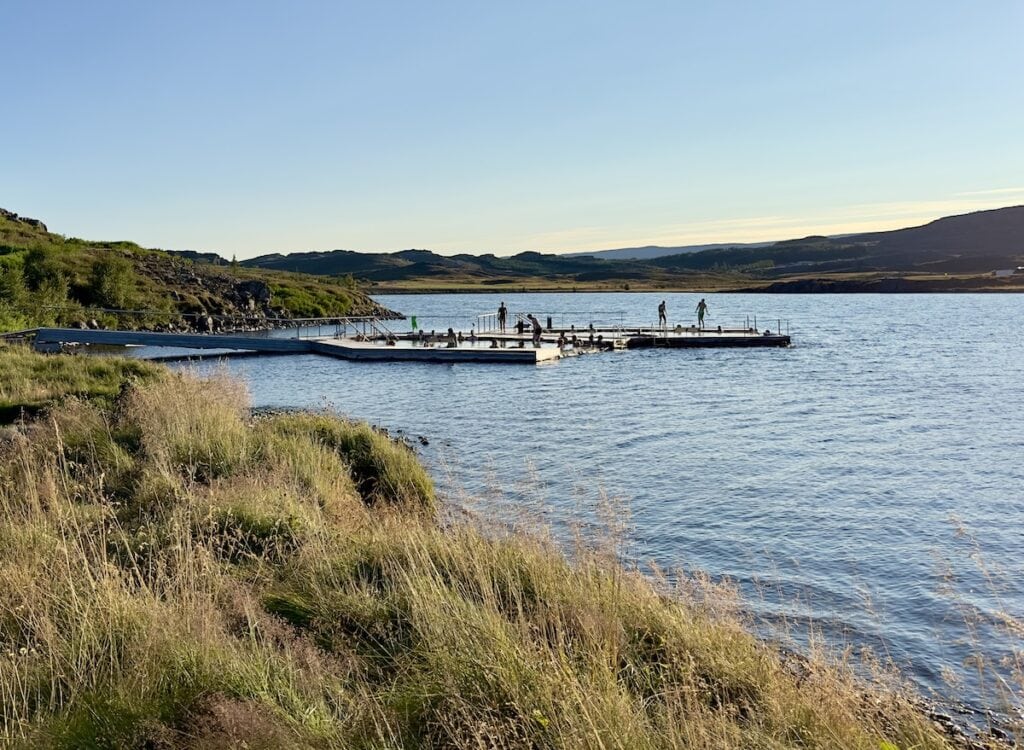
In fact, the list of things to do in East Iceland is extensive, featuring stunning basalt columns, majestic waterfalls (including one of the tallest in the country), picturesque towns, and some of the most magical geothermal pools in the country. While most people only spend a day or two in East Iceland, I highly recommend taking a more leisurely pace if you can.
This post begins with some general information, including driving tips and East Iceland weather considerations. However, if you are in a hurry, you can jump straight to list of East Iceland attractions.
GETTING AROUND
While East Iceland’s towns are technically linked by a bus system, it is much easier to visit the attractions by car. Most visitors embarking on a road trip in Iceland rent a car from Keflavik International Airport.
Note: I alway use the local company Lava Car Rental. Learn more in my guide to renting a car in Iceland.)
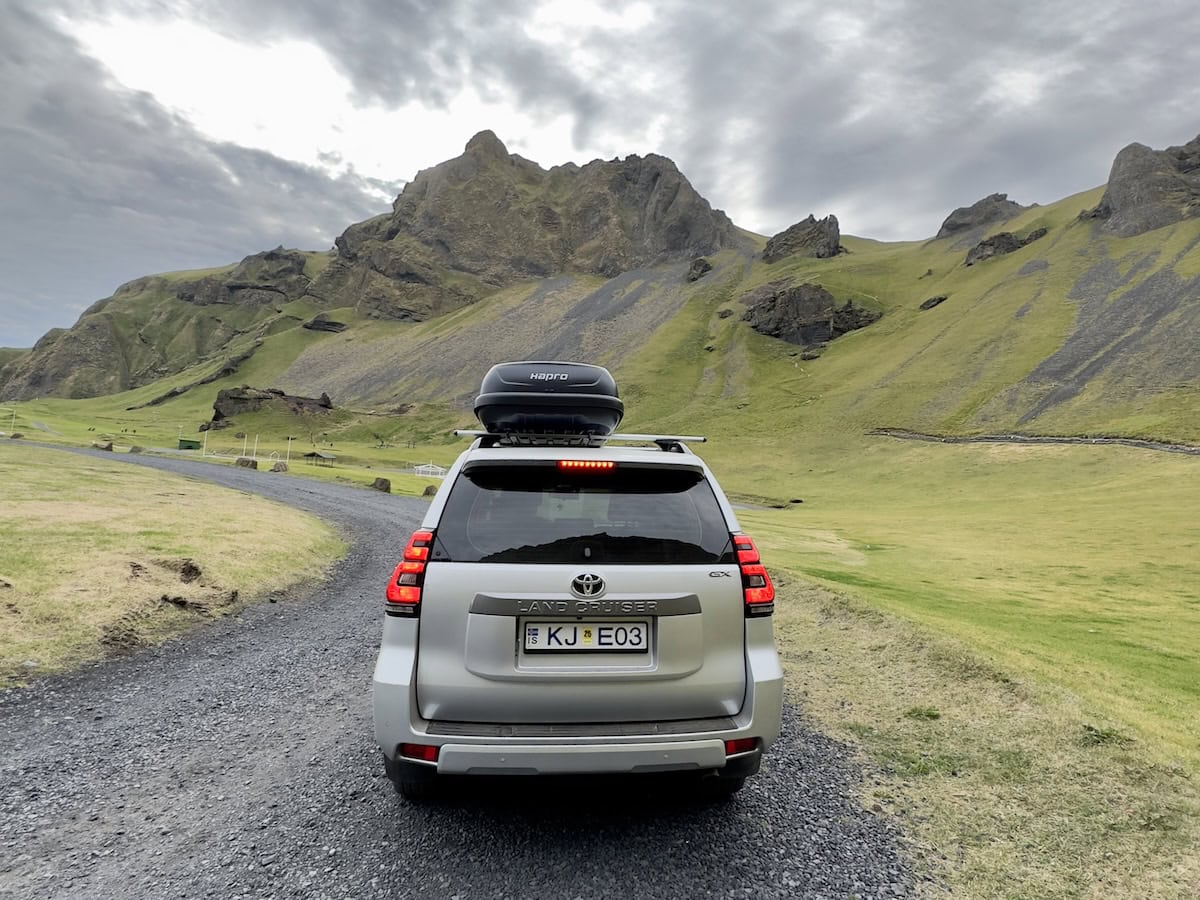
EXCLUSIVE LAVA OFFER
Use the code BEYOND at checkout to save 5% on your rental—just for my readers, thanks to my partnership with Lava Car Rental.
Alternatively, there is a small airport in the town of Egilsstaðir (central East Iceland) with daily flights from Reykjavik Domestic Airport. This airport has car rentals available, so if you are limited on time and exclusively want to visit the east and north of the country, this could be a convenient solution.
The scenic East fjords Iceland route is also very popular in the summer months for both cyclists and motorcyclists.
See more about getting around East Iceland at Visit Austurland.
Funny: I couldn’t help but notice that the Visit Austurland (East Iceland) website even recommends hitchhiking as a way of getting around. As Iceland is one of the safest countries in the world, it is not uncommon to accept a ride from a stranger. (Even I have done it in Iceland, which is certainly not something I would do at home!)
EAST FJORD ICELAND DRIVING TIPS
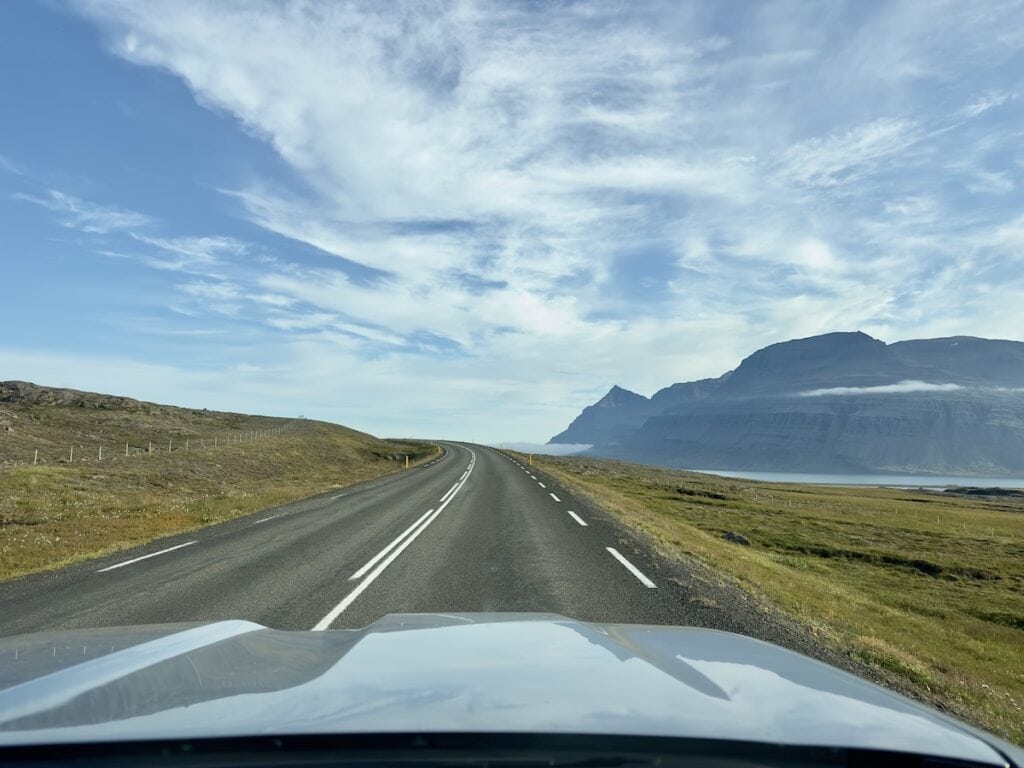
There are quite a few unique things to know about driving in Iceland, which I cover in the linked guide above. Specific to driving in the east, however, I’d like to mention a couple of key points.
- If you stick to the paved main roads (Route 1) and are driving in the summer months, you should be fine with just a regular vehicle. A 4×4 is really only necessary if you plan on traveling on Iceland’s rugged F-Roads or visiting the remote Westfjords.
- It is important to always keep your fuel topped up while driving the East Fjords as the towns are quite spread apart in this region. In the small towns and villages of East Iceland, gas stations double as community hubs, with a store and, oftentimes, a very decent cafe or restaurant.
- While driving, always keep an eye out for animals. Sheep often graze near roadsides and sometimes wander onto the road.
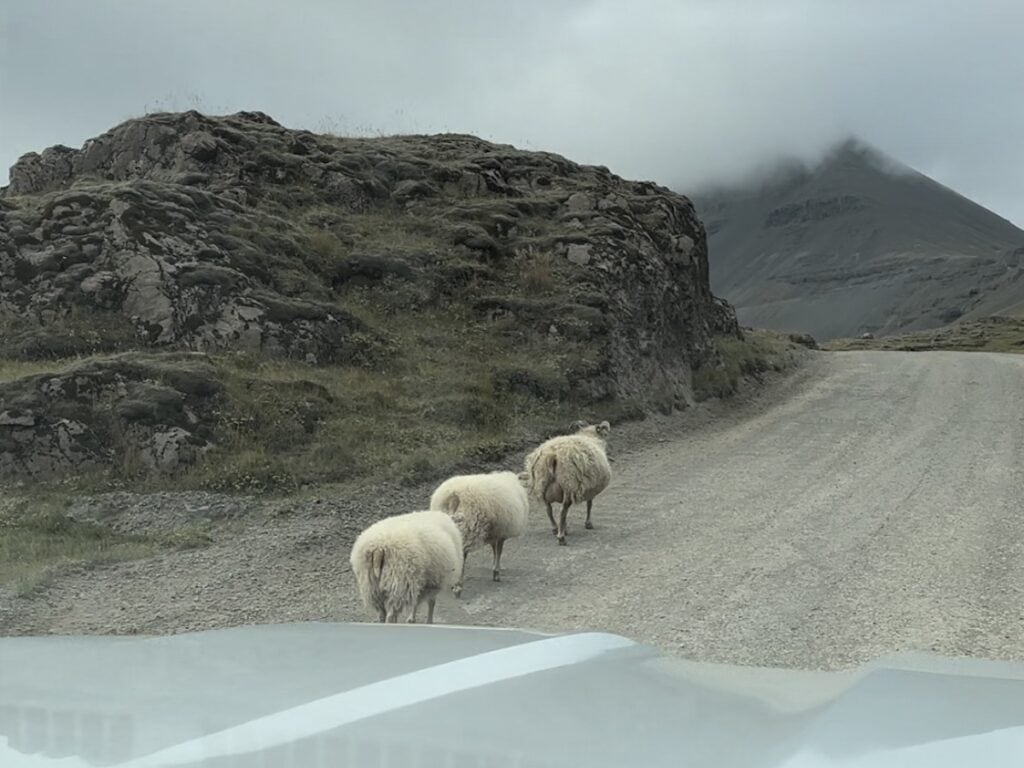
A FERRY TO EAST ICELAND
Perhaps the most interesting thing I discovered while touring East Iceland is that there is a passenger and car ferry that runs between Denmark, the Faroe Islands, and the town of Seyðisfjörður in East Iceland. Unfortunately, there is no car rental location in this tiny Icelandic town (population 600). To get a rental car, you would need to take a bus to Egilsstaðir. Learn more about the Iceland to Denmark ferry route.
WEATHER IN EAST ICELAND
Summers are generally mild, with temperatures ranging from 10°C to 15°C (50°F to 59°F), providing pleasant conditions for exploring the fjords and hiking trails.
Winters can be harsh, with temperatures often dropping below freezing, and snowfall is common, especially in the mountainous areas. The coastal regions tend to be windier and wetter, while the inland valleys may experience more stable weather.
I wanted to share with you the photo below from our Eastern Fjords summer drive in August. This is what the roads looked like 90% of the time, with just the odd light shower. Regardless of the season, however, it’s always wise to be prepared for sudden changes in weather, as Iceland’s climate can be unpredictable.
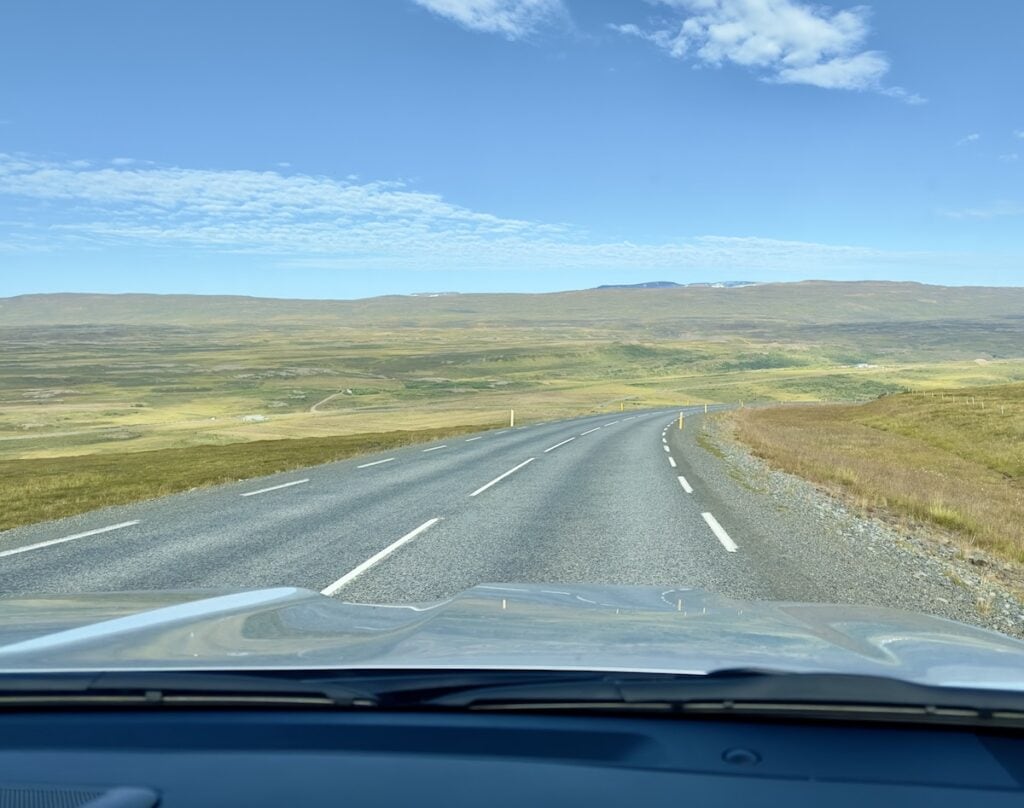
Note: Personally, as a tourist, I would not plan a self-driving road trip of East Iceland or the Ring Road in the winter. The conditions are just too unpredictable. If this is really something you want to do, I recommend taking a tour with an experienced driver.
Please see my photo below from a road trip along the South Coast of Iceland in February. (And the South Coast roads receive more traffic and are quite well-maintained in comparison to those in the east, north, and west.)
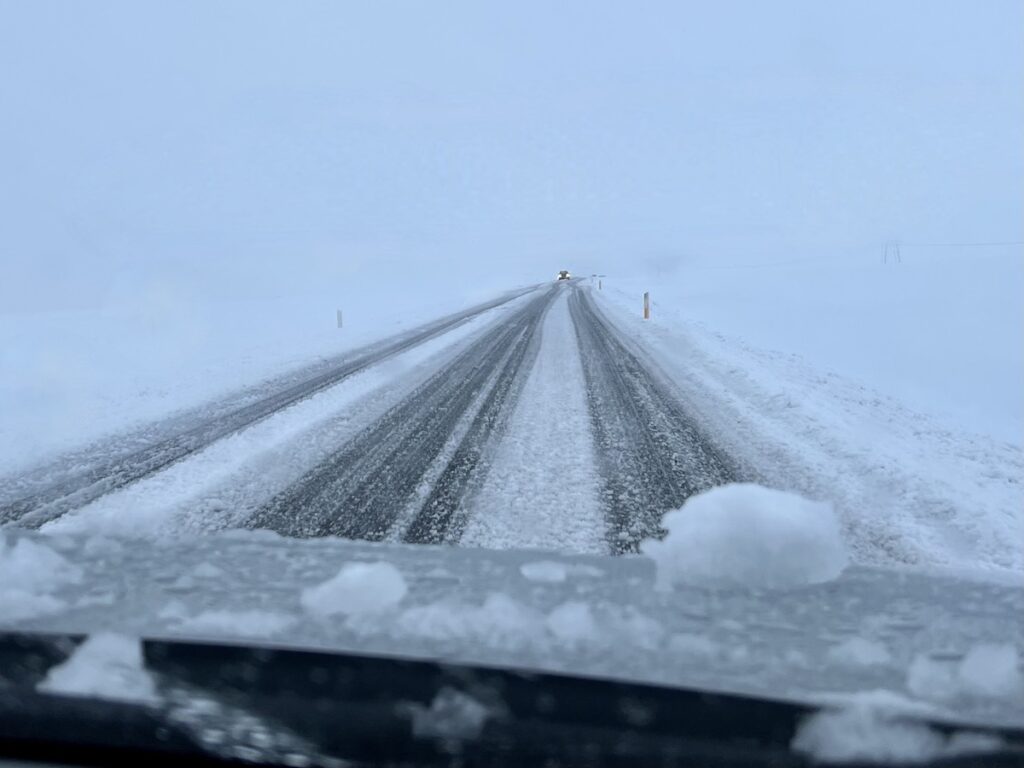
ICELAND EAST ATTRACTIONS MAP
I love a visual! While I have detailed all my favorite places to visit in the East Iceland things to do section below, for your convenience, I have also plotted them on this East Iceland Attractions Map Please feel free to click on the image or the link above for the interactive version.
Note: On this map, I have included the Glacier Lagoon, Diamond Beach, and the town of Höfn, which is just east of those attractions, even though they are all technically part of South Iceland. The reason I have done this is because very few South Iceland travel itineraries include Höfn, despite it being the closest town to those glacier attractions and potentially a good place to spend the night. (The closest town to the west is Vík, which is more than a two-hour drive away.)
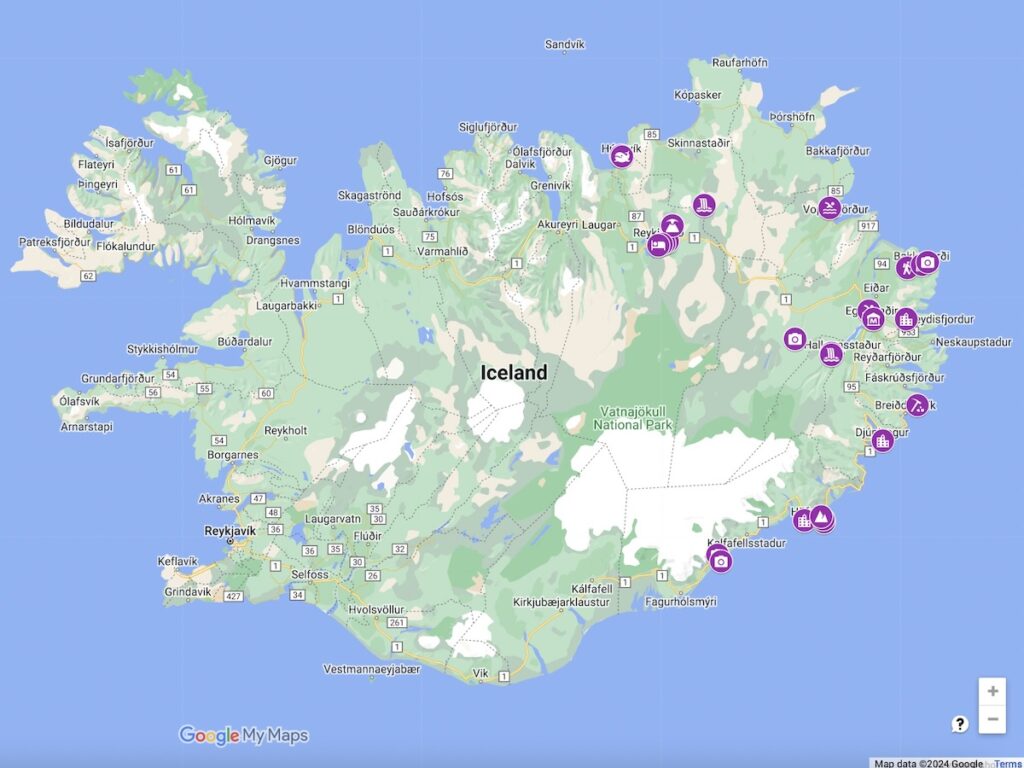
BEST THINGS TO DO IN EAST ICELAND
If you are wondering what to do in East Iceland, fear not. In this section, you will find more than enough incredible places to fill up your East Iceland itinerary.
In a separate post I have on self driving the Iceland Ring Road, I recommend taking a counter-clockwise route. For this reason, I have arranged the following East Iceland attractions in that order – starting from South East Iceland and working up to North East Iceland.
Most of the attractions in the eastern region of Iceland are along Route 1 (also known as the Ring Road that circumnavigates the country). If not, they are just a short distance from it.
So, without further ado, here we go!
EXPLORE HÖFN
This charming town is situated on a narrow peninsula in Southeast Iceland, offering beautiful views of Vatnajökull National Park and showcasing a harbor filled with colorful boats. Höfn is located just one hour east by car from Jökulsárlón Glacier Lagoon, Diamond Beach, and the staging area for many Vatnajökull Glacier tours.
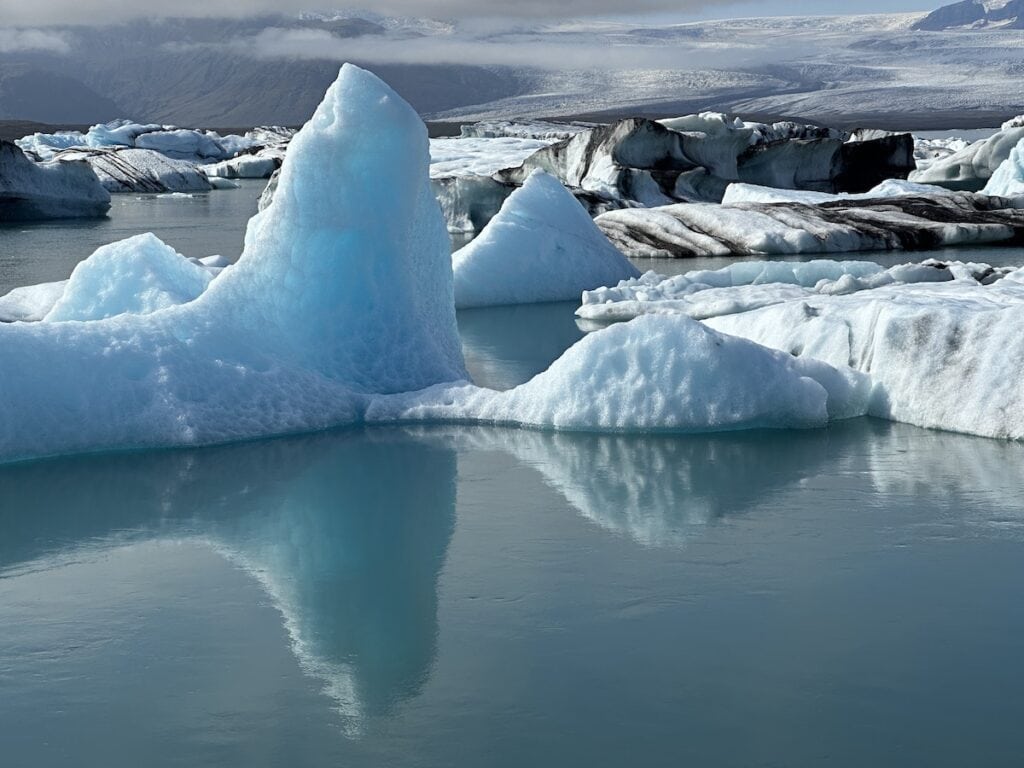
Höfn can make sense for an overnight stay either before or after an exciting day enjoying these glacial attractions, as it is the closest town by proximity. Explore hotels and vacation rentals in Höfn with Booking.com.
Note: There are a smattering of hotels about 30 minutes west Jokulsarlon Lagoon, such as the Fosshotel Glacier Lagoon, but these properties are quite isolated (not in towns).
EASTERN FJORDS ICELAND
I cannot write about things to see in East Iceland without mentioning the spectacular fjord views. When I think back on our time in this region, the incredible vistas around every corner or on the far side of every tunnel are what first come to mind.

Keep that camera at the ready, especially for the Southeast Iceland coastal section from Höfn to Breiðdalsvík. The drive is absolutely stunning!
STOKKSNES AND VESTRAHORN
Located on the southeastern coast of Iceland, is a stunning and dramatic headland known for its black sand beaches, rugged mountains, and striking vistas.
The area is dominated by the Vestrahorn Mountain, famous for its jagged peaks that rise sharply from the sea, creating an iconic silhouette.
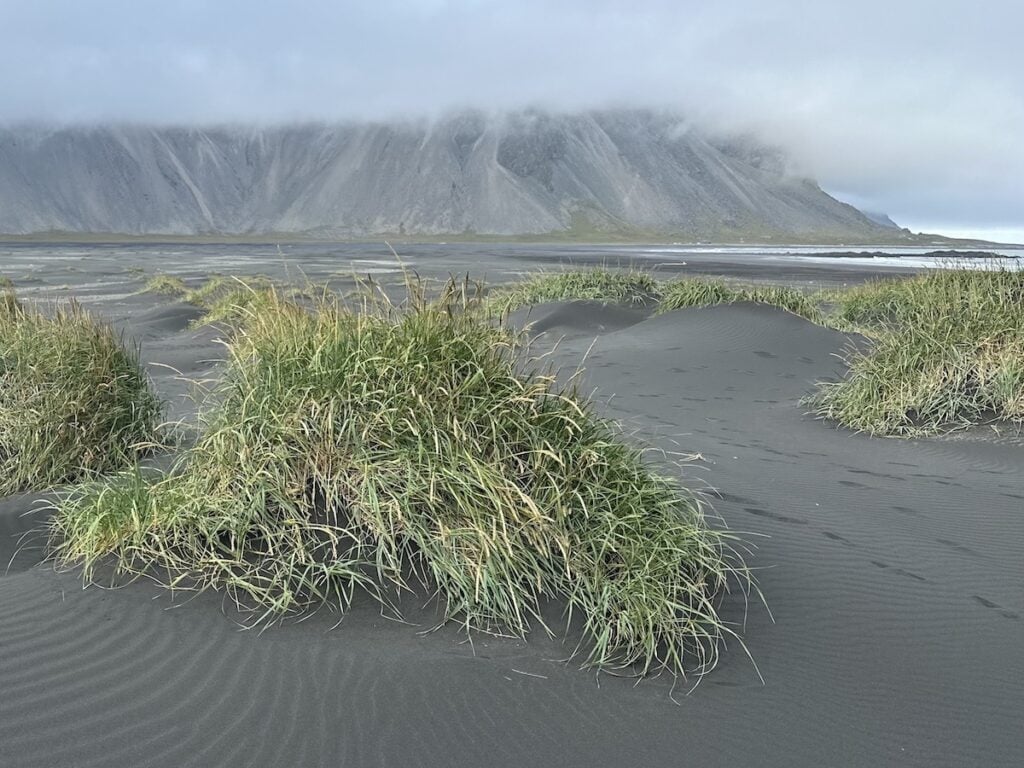
Note: Part of the reason I urge you not to rush through the east coast of Iceland is because I didn’t have as much time here as I wanted. As an amateur photographer, I really wanted to capture the perfect photo of the magnificent jagged peaks of Vestrahorn. Alas, that’s not the photo I got. The top of the mountain is totally obscured by the clouds!
UNIQUE ATTRACTION ALERT: Right at the parking lot for Stokksnes, there is a very unusual Viking Village. This village was built as a movie set. You should come for the beach and the Vestrahorn views, but if this piques your interest, at 1000 ISK (tickets bought at the café), it is pretty inexpensive by Icelandic standards.
DJÚPIVOGUR
Traveling further east, you’ll reach Djúpivogur, a small fishing village known for its rich birdlife and arts community. The village is part of the Cittaslow movement, which promotes a slow-paced, high-quality life.
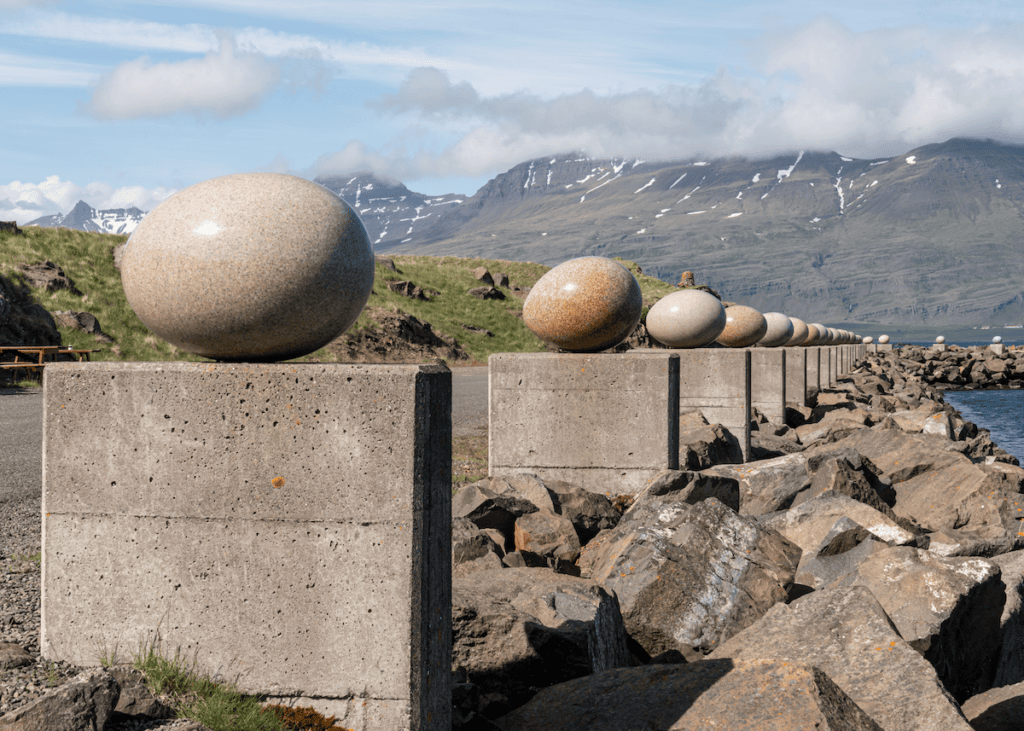
In town you will find the outdoor art installation Eggin í Gleðivík (Eggs at Merry Bay) by renowned Icelandic artist Sigurður Guðmundsson – consisting of 34 large granite eggs, representing the bird species that nest in the area.
In the past, you could join a boat tour from Djúpivogur to Papey Island just offshore, home to thousands of puffins and other seabirds. I do not believe such tours are available at this time, but if I learn of one, I will share it here.
STODVARFJORDUR
Continuing east, you’ll arrive in the village of Stöðvarfjörður, known for its artistic community and a stunning fjord backdrop.
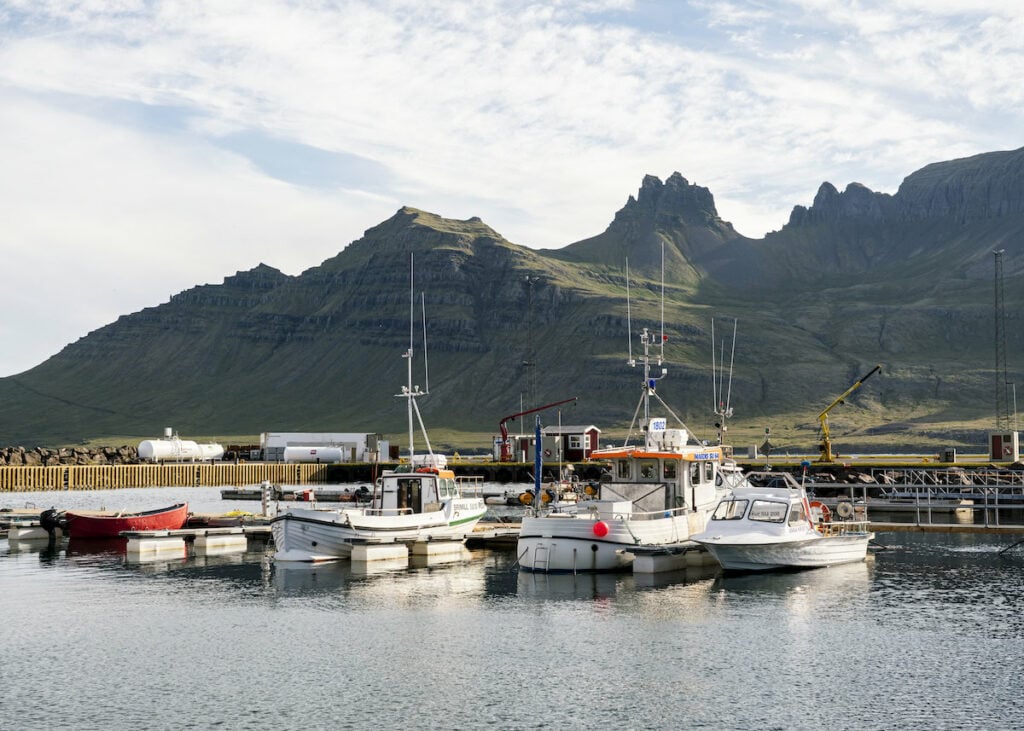
Many East Coast Iceland visitors make a short stop in this town to see Petra’s Stone Collection (an absolute must for geology enthusiasts), which showcases thousands of stones and minerals collected by local legend Petra Sveinsdóttir. The collection is displayed in her former home and garden, offering a unique and personal touch.
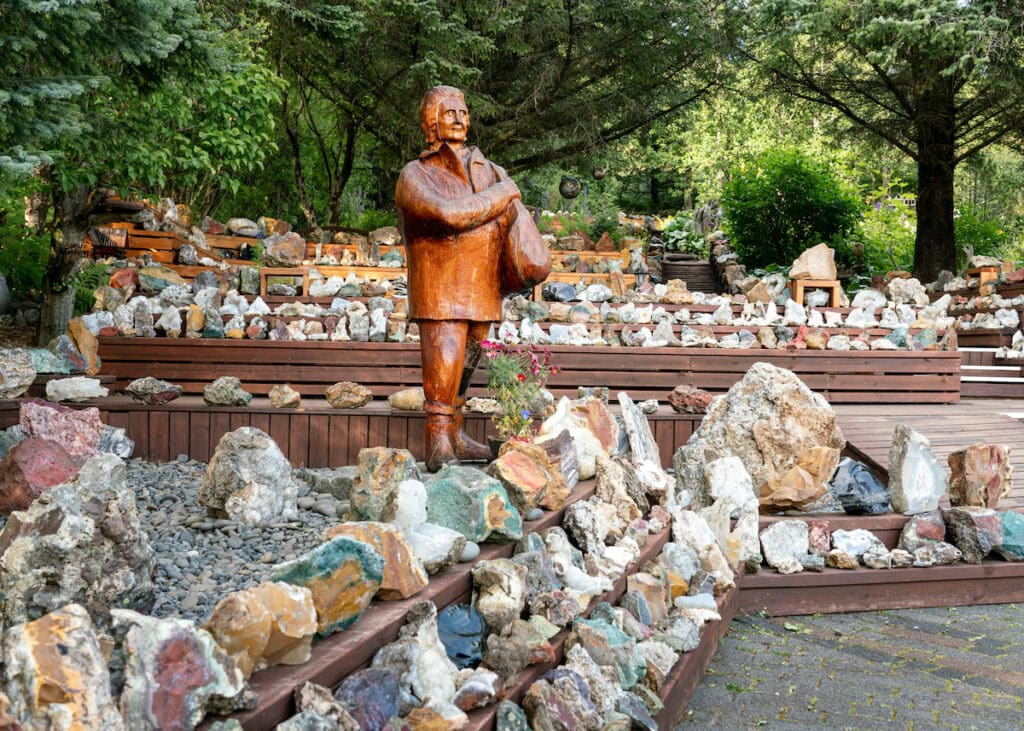
Also interesting to see in the area is Saxa, a natural rock formation where the sea waves crash into a crevice, creating a spectacular spouting effect.
SEYDISFJORDUR
Seyðisfjörður is a vibrant town nestled in a fjord and surrounded by mountains. It is a bit out of the way (you have to navigate numerous hairpin turns), but it is well worth the visit to experience its colorful wooden houses, artistic community, and rich cultural heritage.
The town is probably most famous for its Blue Church and Rainbow Road. It also boasts a stunning mountain backdrop, charming hotels, and some delightful restaurants.
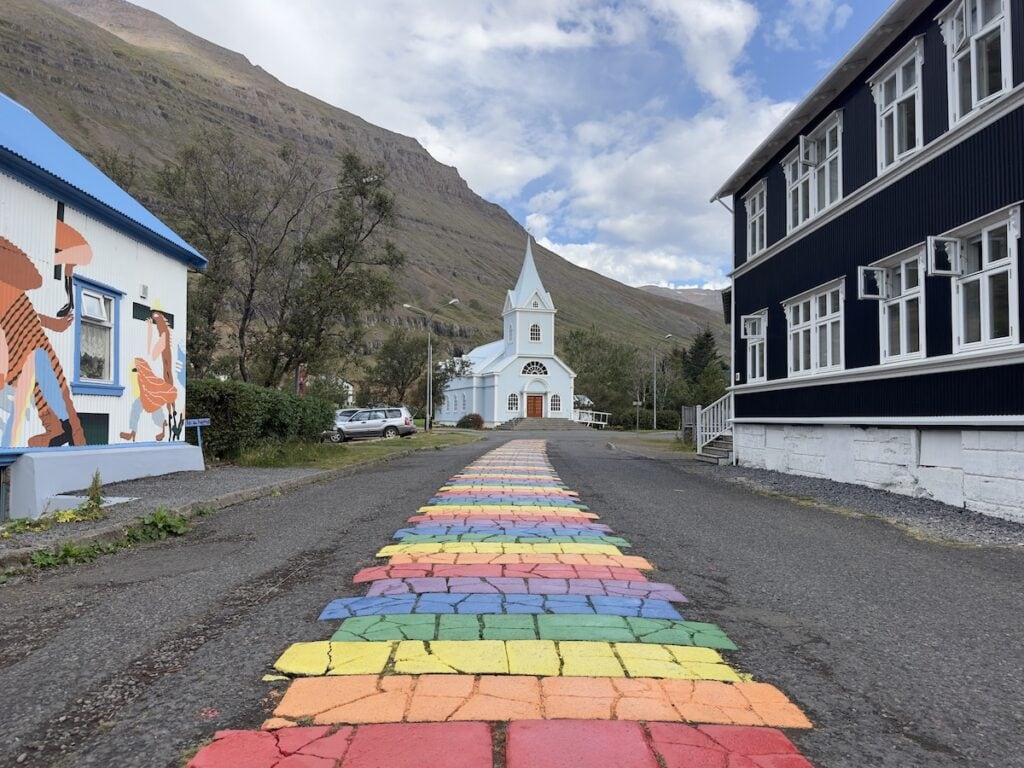
Just outside Seyðisfjörður, the Skálanes Nature Reserve offers hiking trails with breathtaking views of the fjord. The area is rich in wildlife, including reindeer, seals, and a variety of birds.
Seyðisfjörður is also home to numerous art galleries and studios. The Skaftfell Center for Visual Art is a notable venue, hosting exhibitions, artist residencies, and cultural events throughout the year.
WHERE TO STAY IN SEYDISFJORDUR
We chose to stay several nights in Seyðisfjörður when we couldn’t find a suitable place in nearby Egilsstaðir. The mountain backdrop of this town reflecting off the lake is truly stunning. Check out the view from our room! (I highly recommend Vid Lonid Guesthouse!)
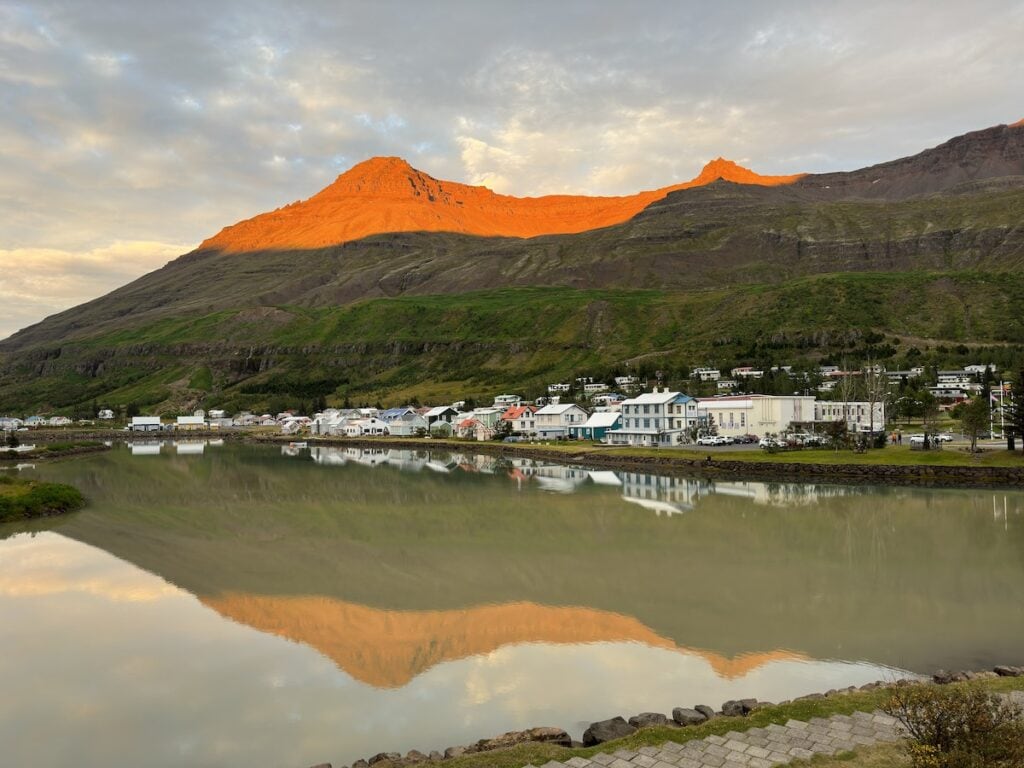
Two other guesthouses in Seydisfjordur that get great reviews are Hotel Aldan – The Bank and Hotel Aldan – The Old Schoolhouse (sleeps 6). See more options on Booking.com.
Note: Earlier in this post, I mentioned that you can sometimes get great food at gas station restaurants in Iceland. The organic café called The Filling Station inside the gas station in Seyðisfjörður is absolutely one of those places!

EGLISSTADIR
Egilsstaðir is the largest town in East Iceland and makes for the perfect base for exploring the surrounding attractions. The town offers all the amenities you might need, including restaurants, shops, and accommodation options. It also has an airport with daily service from Reykjavik.
Eglisstadir is home to The East Iceland Heritage Museum, offering a comprehensive look at the history and culture of East Iceland. Exhibits include traditional crafts, historical artifacts, and stories of the region’s settlers.
Iceland’s largest forest Hallormsstaðaskógur is located near Egilsstaðir and is ideal for hiking, picnicking, and birdwatching. The forest is crisscrossed with well-marked trails, offering a serene escape into nature.
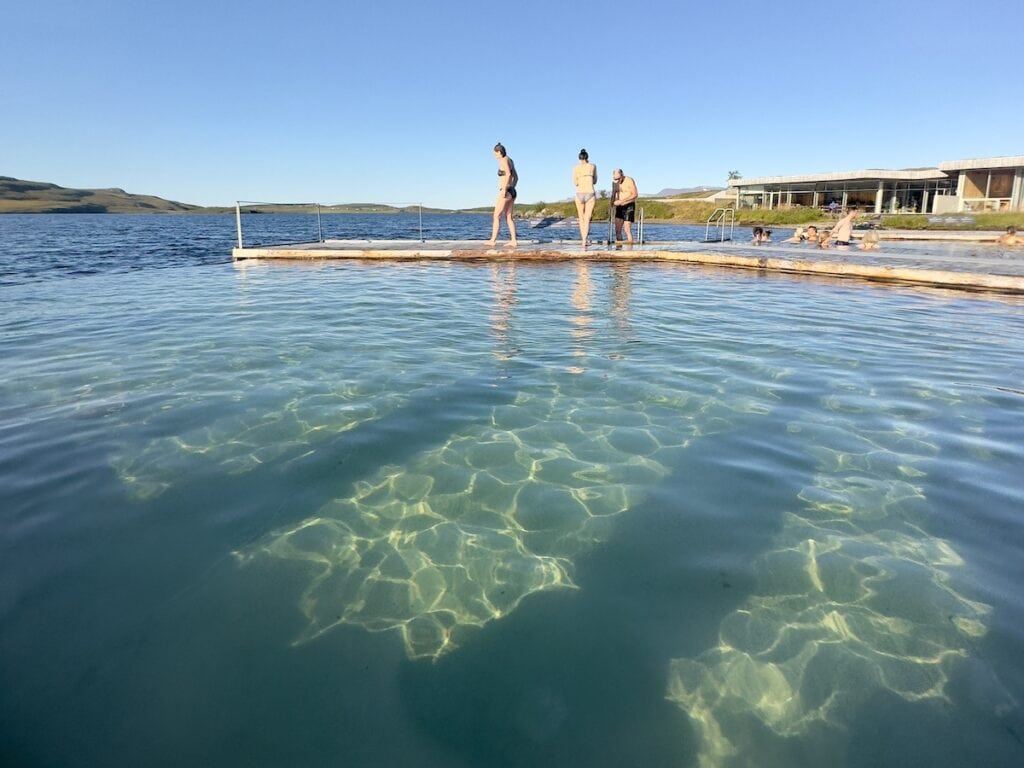
Although we have visited many geothermal pools in Iceland, Vök Baths in Eglisstadir is one of our all-time favorites. It is much more natural than some of the others (no chemicals!) and the location allows you to jump back and forth between the hot pools and the lake.
Note: Peak midday times for Vök Baths do sell out in advance (especially if there is a cruise ship in port). Check availability and pricing on Viator.com.
WHERE TO STAY IN EGLISSTADIR
Despite being a central hub, Egilsstaðir has precious few hotels. These hotels are often fully booked by tour groups during the summer months. That said, if you can score a room at a good Egilsstaðir hotel or guesthouse, grab it—well done!
The two hotels I would recommend in Eglisstadir are Gistihusid Lake Hotel (3★) and Hotel Nott 1001 (4★). See more options, including some charming vacation rentals on Booking.com.
As mentioned earlier, we ended up staying in nearby Seydisfjordur, which we loved, but it did required a little more driving for our day trips in the area.
STUDLAGIL CANYON

Due to the fact that this attraction is slightly off the beaten track (a one-hour drive east of Egilsstaðir), many Iceland Ring Road tours skip it. However, seeing these basalt columns was one of our favorite experiences in East Iceland. I highly recommend the slight detour off the main route if you have the time.
Studlagil Canyon can be viewed in as little as 15 minutes via a staircase on the north side. (Pay parking, restaurant, and washrooms are available here.) However, the better view is from the south side. (This is where you always see the photos from.)
The parking is free on the south side, but you need to walk about 2 km to the lookout. There is a little waterfall along the way, and then it is just a straight, flat path (without any shade).
The photo below shows both the north side staircase (right) and the south side viewpoint (back left). I also want to point out that when you see Stuðlagil Canyon in professional photos, the water often looks turquoise and clear. When we visited, however, it was quite silty. Both the photo above and the photo below were taken in late August, so it just depends on the conditions.
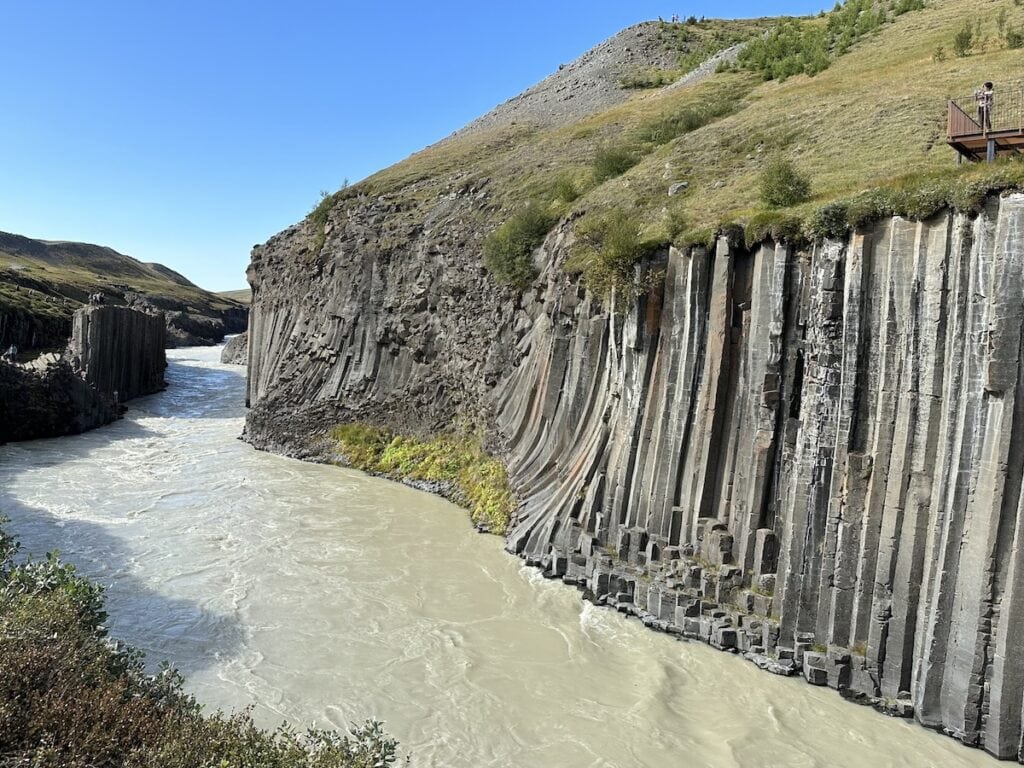
HENGIFOSS AND LITLANESFOSS
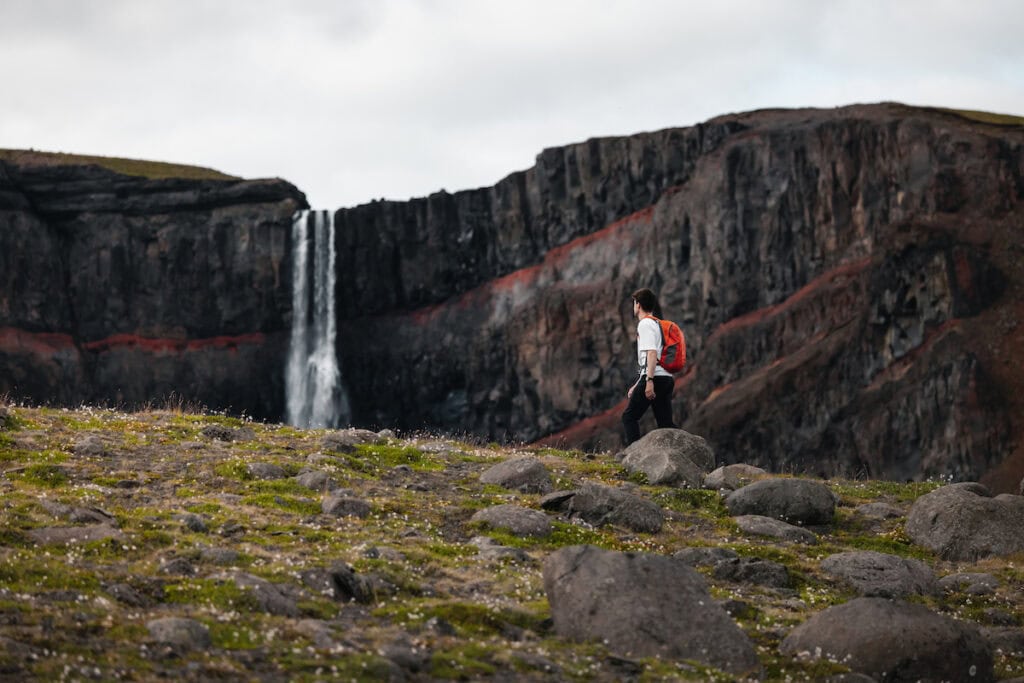
Also in the area is Hengifoss. Hengifoss is Iceland’s third tallest waterfall and can be reached via a moderately hard hike that also passes by the equally stunning Litlanesfoss.
The trailhead is about a 30-minute drive from Egilsstaðir. It should be noted that despite the fact that Hengifoss and Stuðlagil Canyon appear quite close on the map, you cannot drive directly between the two; you must return almost to Egilsstaðir.
Most people complete the Hengifoss and Litlanesfoss 5.1k loop trail in 2-3 hours. Proper hiking footwear is advised as the trail can get slippery near the falls. See the route on AllTrails.com.
BORGARFJORDUR EYSTRI
Heading back towards the coast, you will reach Borgarfjörður Eystri, a remote village known for its stunning landscapes and rich folklore. The area is a hiker’s paradise, with numerous trails leading through colorful mountains, luscious valleys, and along rugged coastlines.
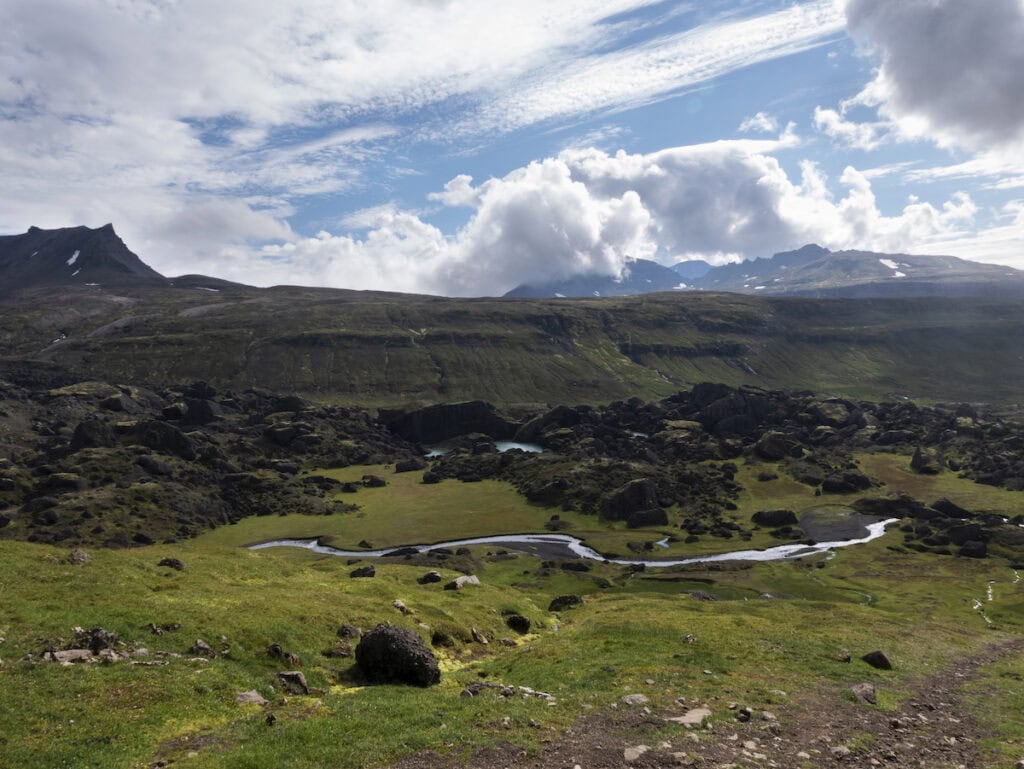
There are several popular hikes in the area including Storurd (The Giant Boulders) that takes you to a hidden valley filled with giant boulders, crystal-clear ponds, and lush vegetation.
According to local legend, Álfaborg (Elf Hill) is the home of the elf queen. Visit the hill and the small museum in the village to learn more about Icelandic folklore and the belief in hidden people.
The best spot for puffin watching (late May to mid-August) is Hafnarhólmi, a small island accessible by a short walk from the harbor. Here, you’ll find well-maintained viewing platforms and paths that allow for close encounters with these adorable seabirds.
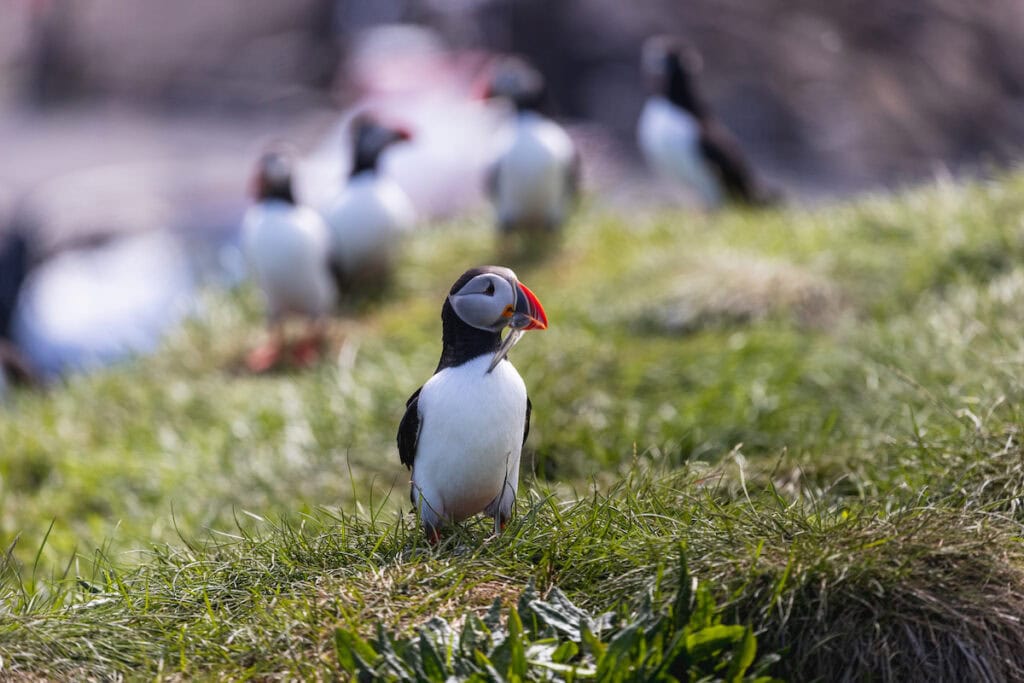
Note: While we did not stop in this town, I definitely would say that it looks like a great spot for puffin viewing. (Even better than where we have made a detour to see them in South Iceland’s Westman Islands.)
Check out the Borgarfjordur Eystri viewing platform in this YouTube video!
Borgarfjordur Eystri also hosts a music festival each July. This 3-day party sees the population of this little hamlet balloon to close to 1000 people from ~300. Learn more at Braedsland Music Festival or watch this short video of the event by Icelandair.
VOPNAFJORDUR
Just a little further north up the coastline is Vopnafjörður, a town steeped in history and surrounded by natural beauty. The local folk museum, Bustarfell, provides a glimpse into traditional Icelandic life with its well-preserved turf houses and artifacts.
The rivers around Vopnafjörður are renowned for their excellent fishing opportunities, particularly for salmon and trout. For those who love hiking, the trails around Krossavíkurfjall mountain provide spectacular vistas and the chance to explore less-traveled paths.
If you want to have a local pool experience, check out Selárlaug Swimming Pool. This pool, with its scenic backdrop, is a perfect spot to unwind after a day of exploring.
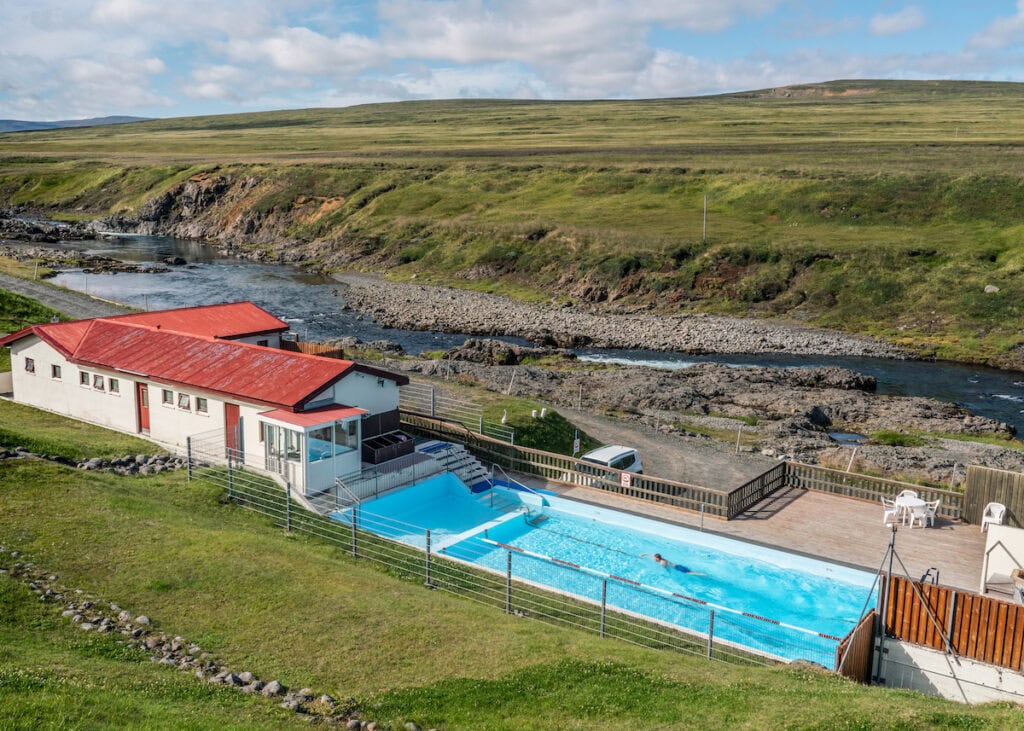
DETTIFOSS
As you continue, your journey will take you inland and to the west in order to reach Dettifoss, Europe’s most powerful waterfall. This awe-inspiring cascade of water plunges 44 meters into the Jökulsárgljúfur canyon.
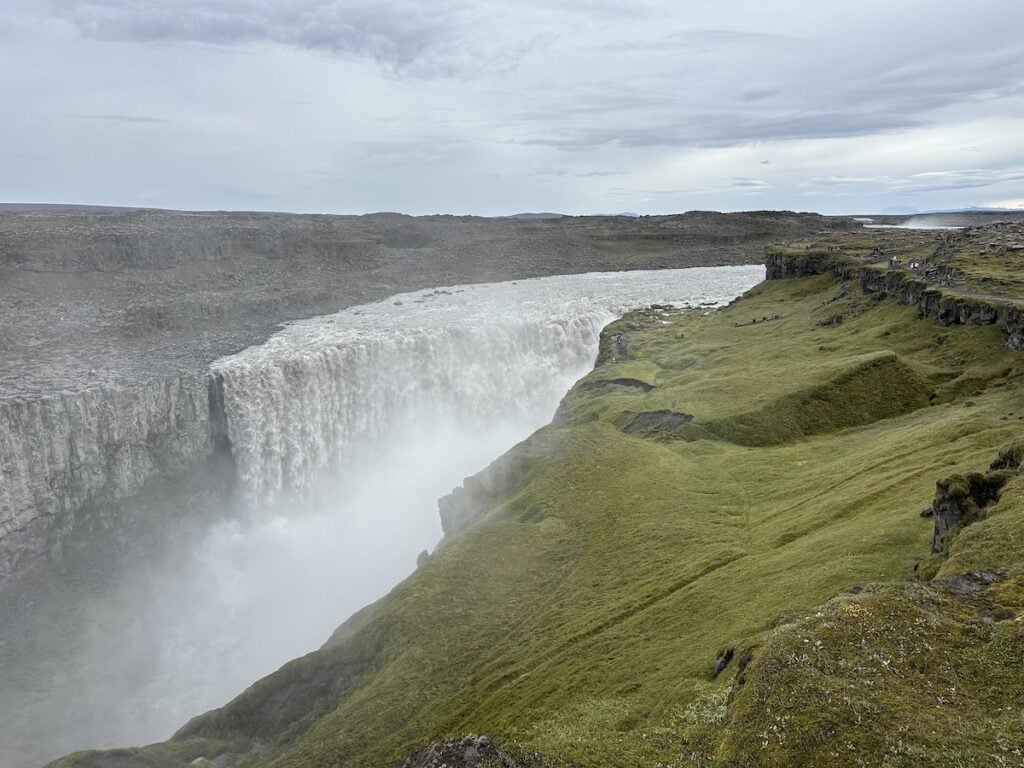
While visiting Dettifoss, be sure to also see nearby Selfoss and Hafragilsfoss waterfalls, each offering their own unique perspective of the mighty Jökulsá á Fjöllum river.
MYVATN GEOTHERMAL AREA
Continue west to Lake Mývatn, a geothermal wonderland with a diverse range of interesting features. The surrounding landscape is dotted with volcanic craters, lava fields, and hot springs, creating a unique and otherworldly environment.
Note: I cannot write about this area without making mention of the smell of sulfer. While it is not uncommon to get a waft of sulfer in Iceland, Myvatn is next level! (It may not bother you in the slightest, but I thought you should know.)
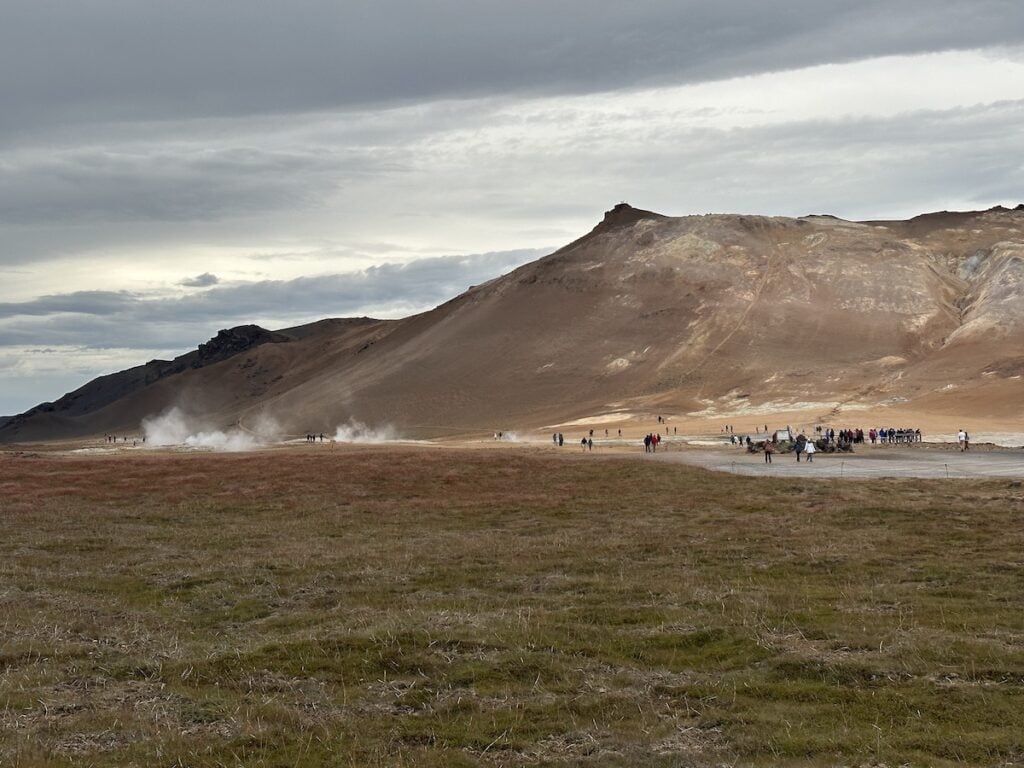
Highlights in this area include the Mývatn Nature Baths, often referred to as the Blue Lagoon of the North and the Hverir geothermal area, where you can witness bubbling mud pots and steaming fumaroles.
Pre-book tickets for Myvatn Nature Baths with GetYourGuide.com.
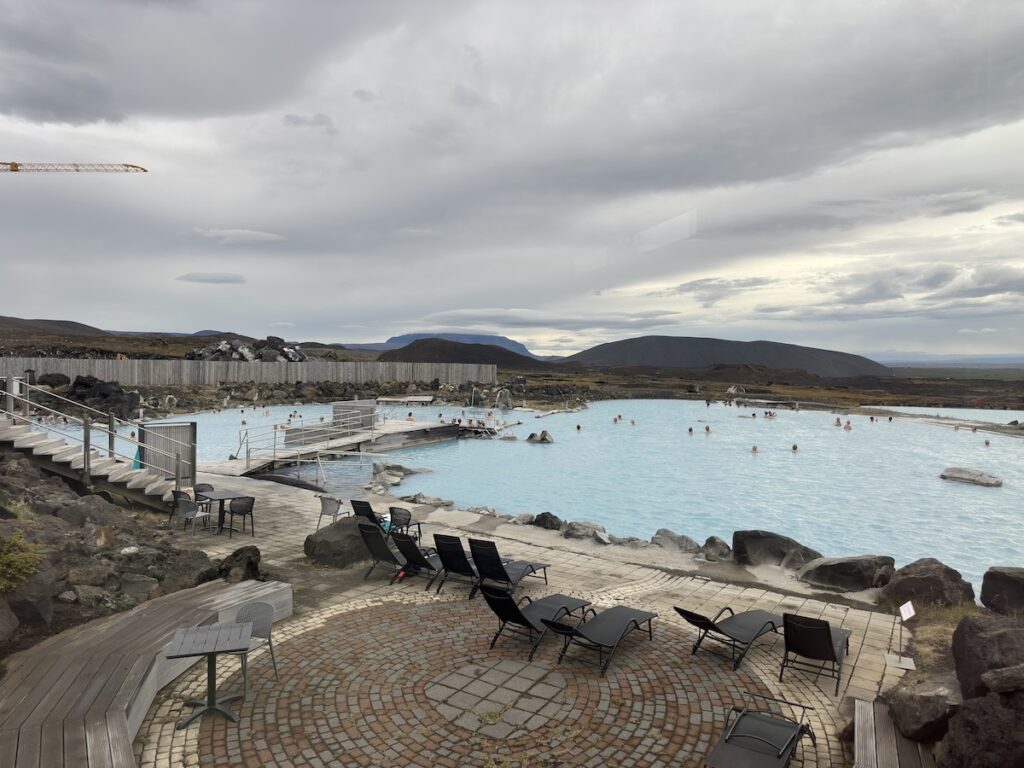
Also interesting in the area are the Dimmuborgir lava formations, which resemble a collapsed citadel and are the subject of many local legends. For a more strenuous adventure, hike up to the Víti Crater in the Krafla volcanic area, offering breathtaking views into the crater lake and surrounding landscape.
Fans of Game of Thrones, may wish to visit Grjótagjá (a steamy cave with a hot pool inside). While interesting to look at, swimming it not permitted here because the water is scalding hot!
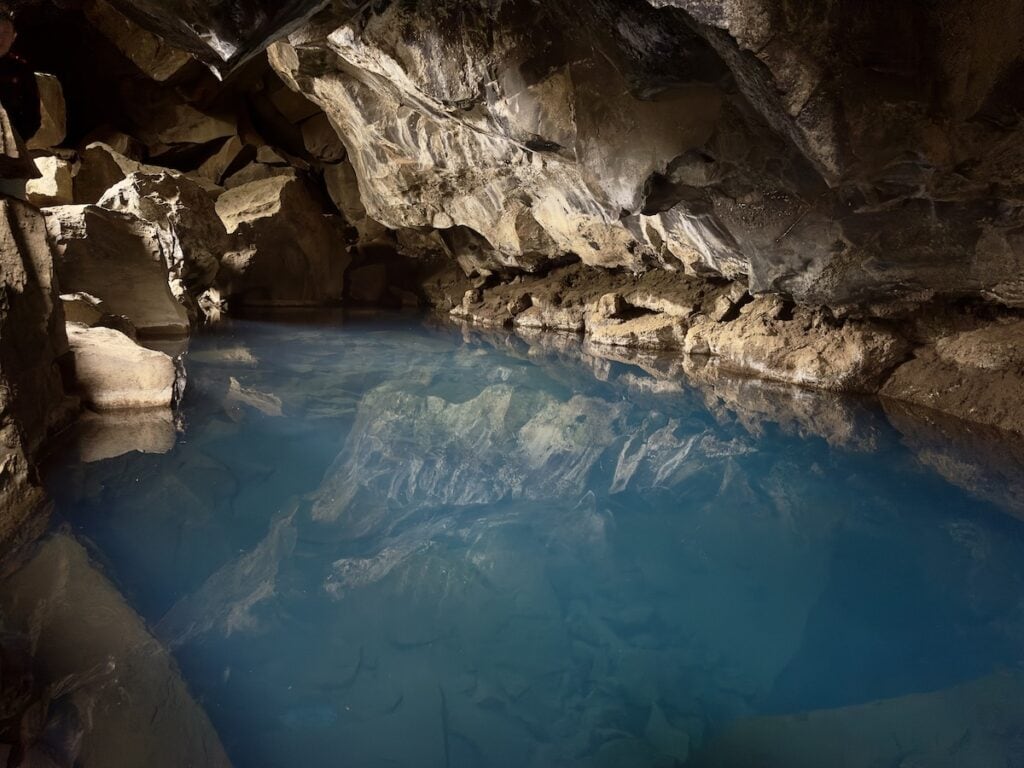
If all your activities make you peckish, Vogafjos Farm Resort has a wonderful farm-to-table restaurant. There is a barn attached to the restaurant where you can visit some of the animals.
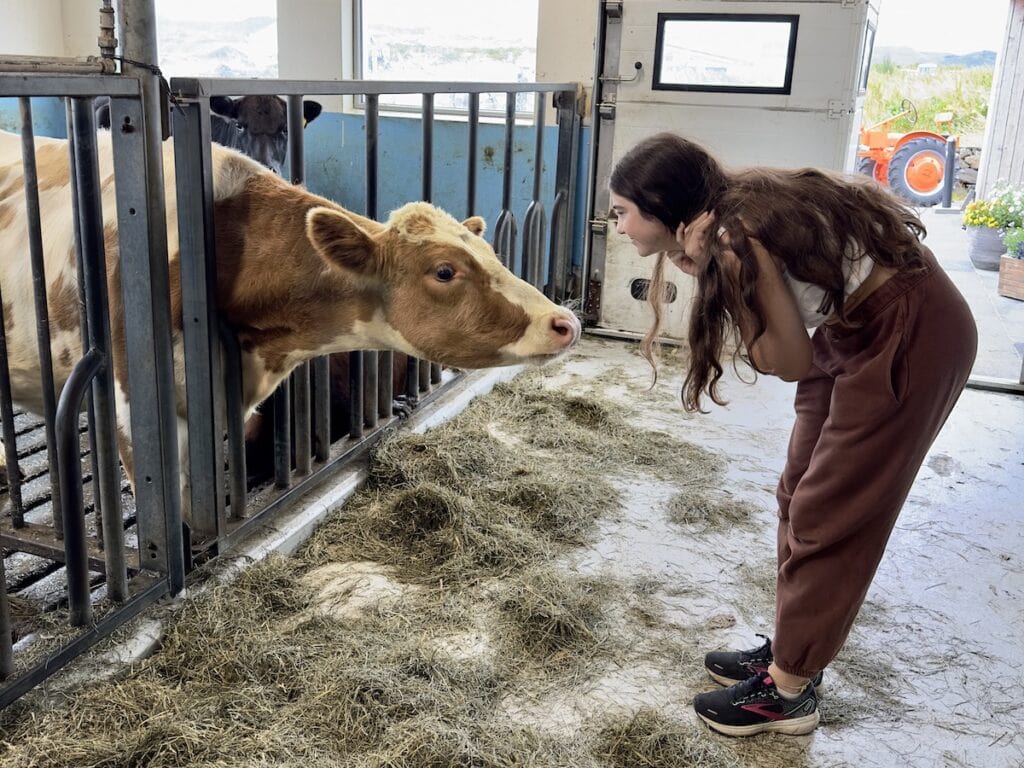
The hotel at Vogafos also gets very good reviews if you are looking for a place to stay in the area. Check rates and availability on Booking.com.
HUSAVIK
As you continue north, make your way to Húsavík, often referred to as the whale-watching capital of Iceland. This charming town on the northern coast is renowned for its excellent whale-watching tours, offering the chance to see humpback whales, minke whales, and even the elusive blue whale.
Another highlight is the picturesque Húsavík Church, a charming wooden structure built in 1907 that showcases Icelandic ecclesiastical architecture.
Lastly, don’t miss the chance to soak in the GeoSea Geothermal Sea Baths, where you can relax in warm, mineral-rich waters while enjoying stunning views of Skjálfandi Bay and the surrounding mountains.
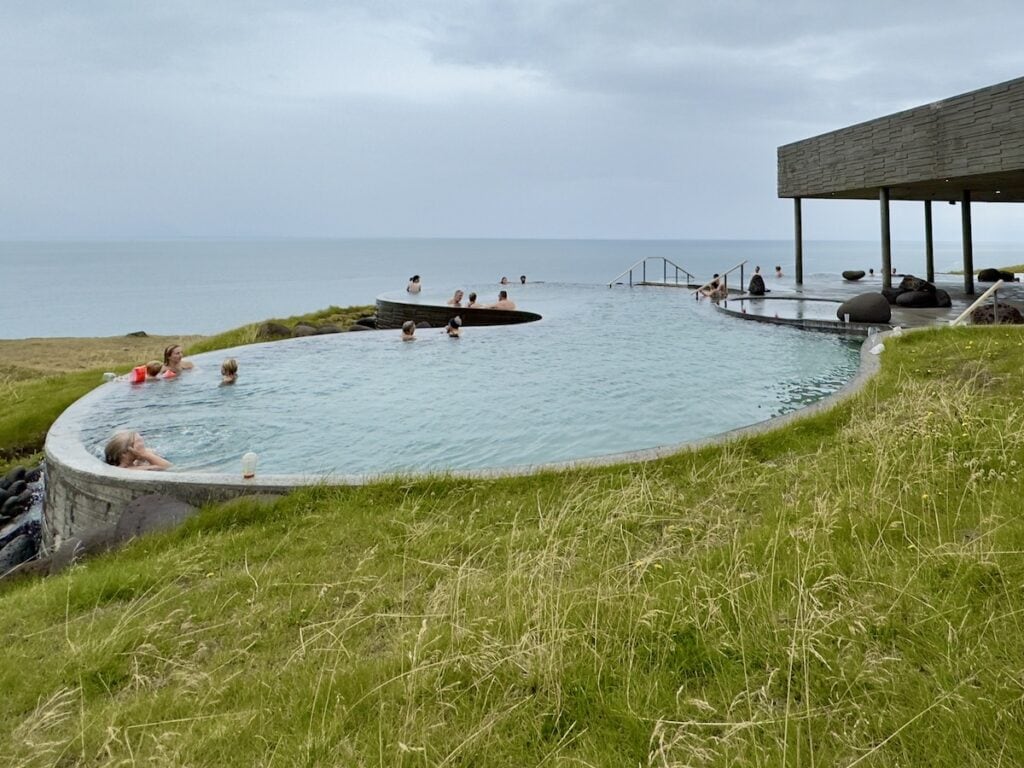
GeoSea is our second favorite geothermal pool in Iceland. Its cliffside location, next to a very accidentally Wes Anderson lighthouse, feels simply out of this world!
See tickets for GeoSea on GetYourGuide.com.
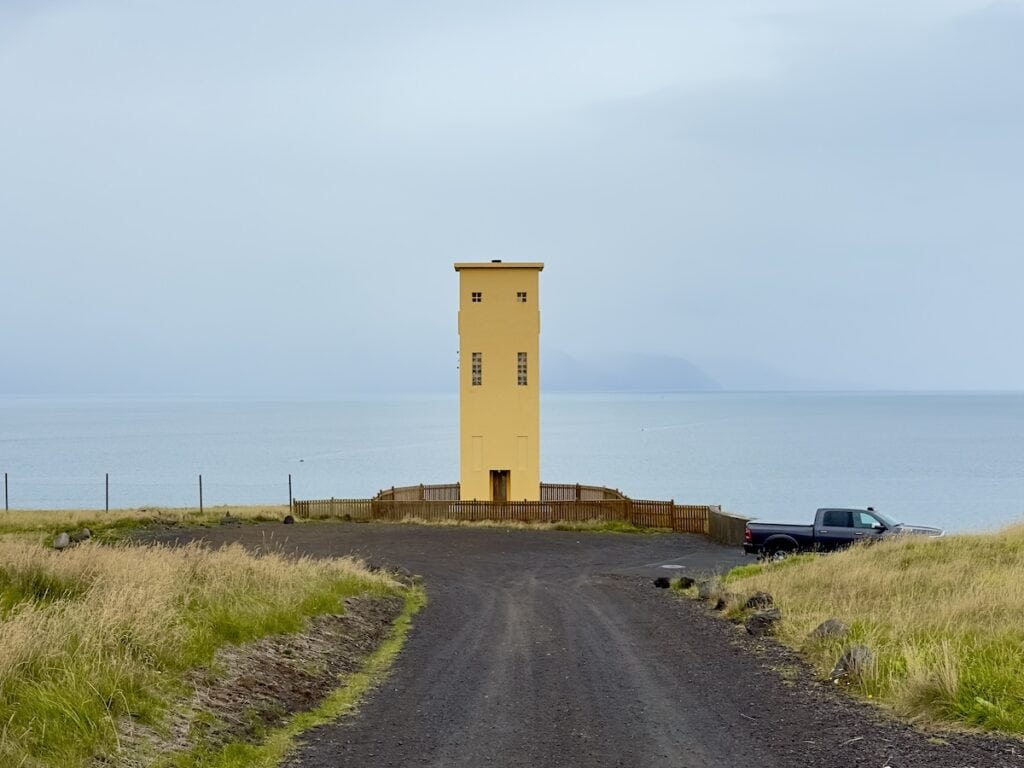
WHERE TO STAY IN HÚSAVÍK
If you wondering where to stay in Husavik, both the Fosshotel Husavik and the Husavik Cape Hotel are very nice.
If you prefer a more intimate, boutique hotel experience, I would recommend Laxhús Guesthouse or Arból Guesthouse.
See more Husavik hotels on Booking.com.
CONCLUSION
East Iceland offers a unique blend of natural beauty, cultural richness, and adventurous activities that make it a must-visit destination. From the dramatic fjords and majestic waterfalls to the charming towns and vibrant art scenes, there’s something for everyone to enjoy.
Should you have further questions about this East Iceland itinerary, please feel free to reach out to me via direct message on Instagram, by email, or by leaving a comment below. I love hearing from readers.
MORE ON ICELAND
- Self Driving the Iceland Ring Road
- How to See Iceland’s Blue Ice Caves
- The 10 Best South Coast Iceland Hotels
- A Guide to Iceland’s Westman Islands
- Self Driving the Golden Circle, Iceland
- 20 Things to do in Reykjavik with Kids
- 10 Best Things to do in Iceland in Winter
- 15 Tips for Self Driving Iceland in the Winter
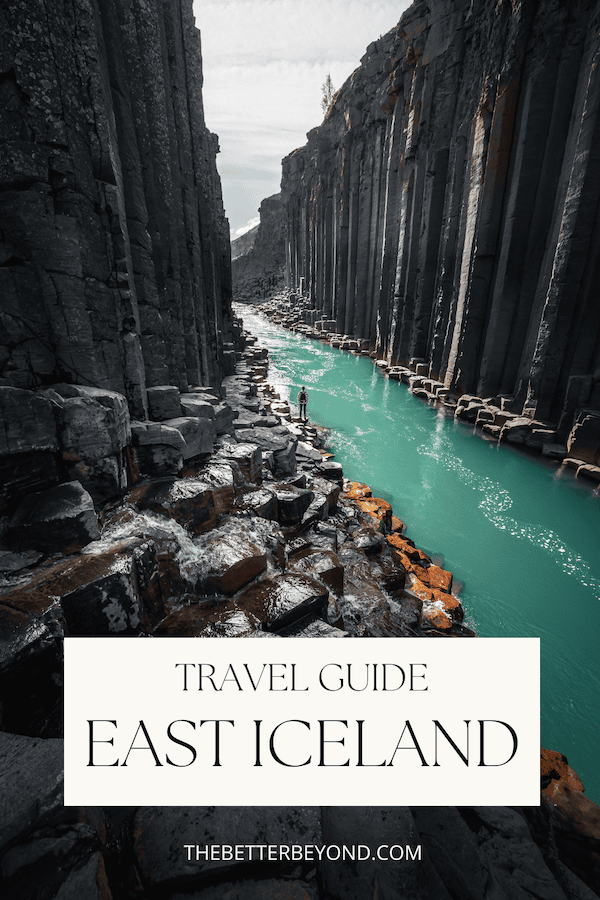
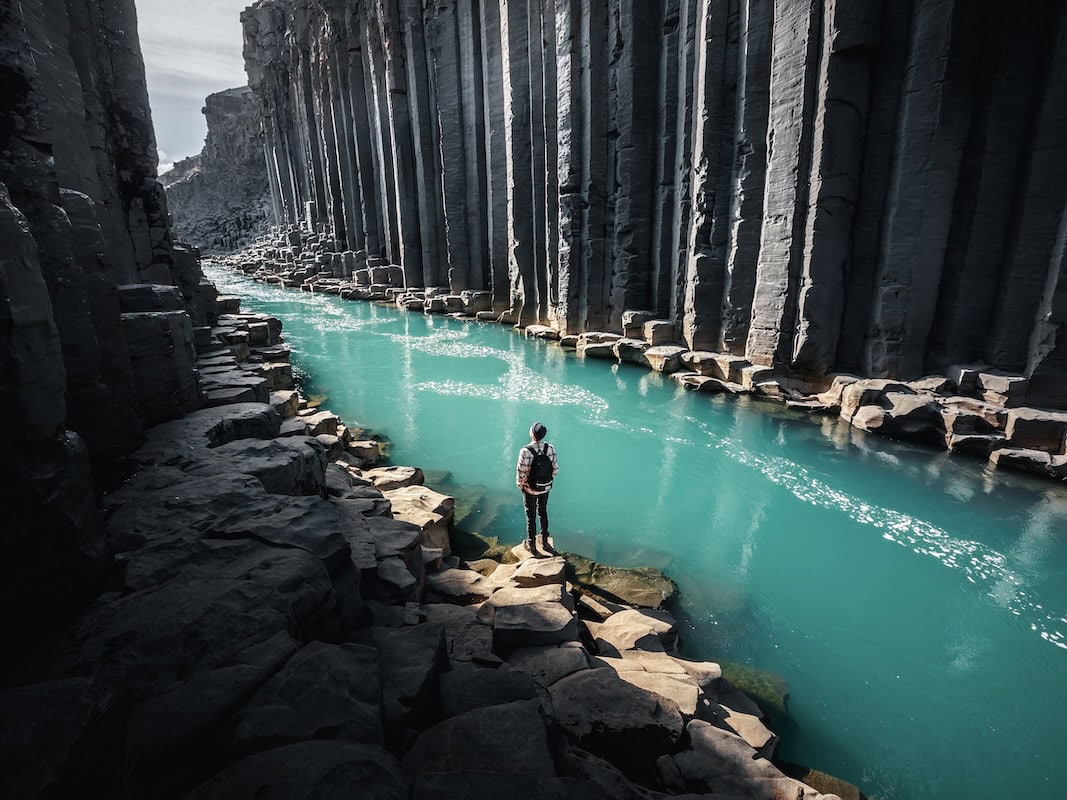
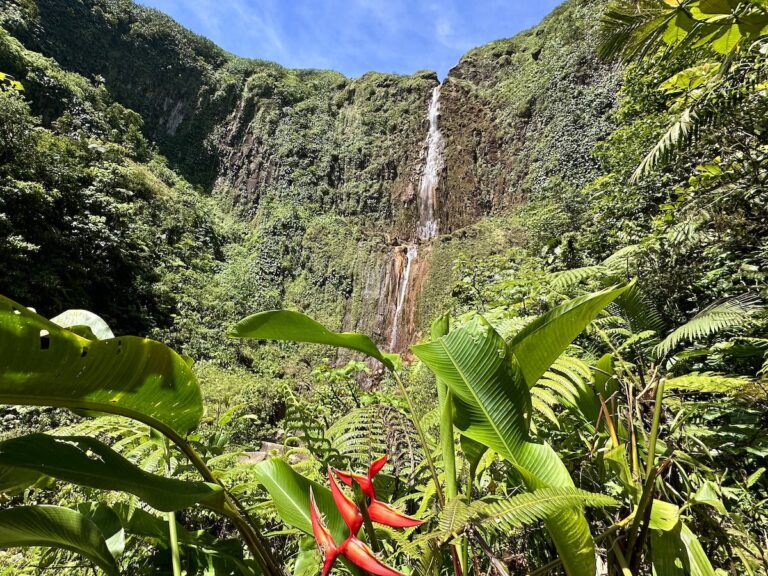
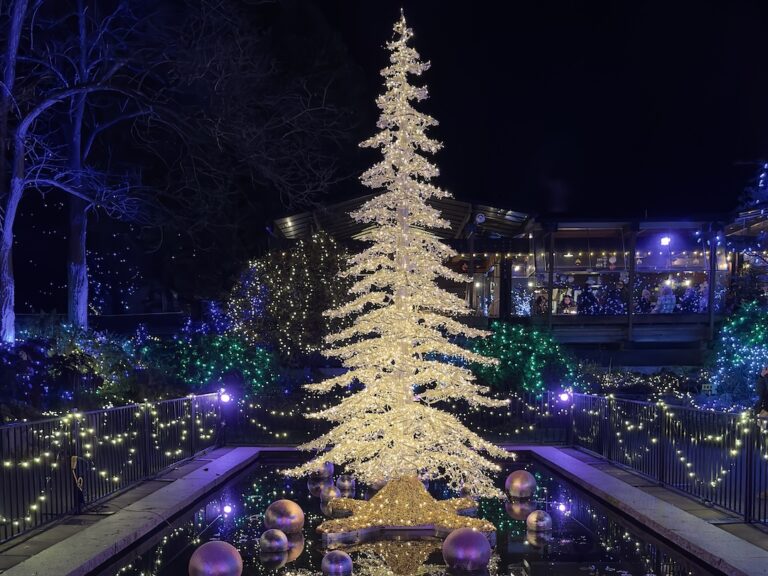
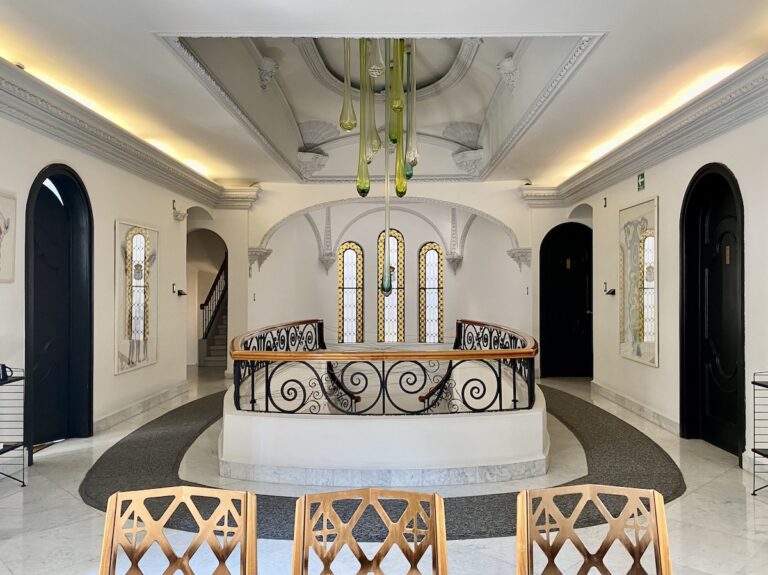
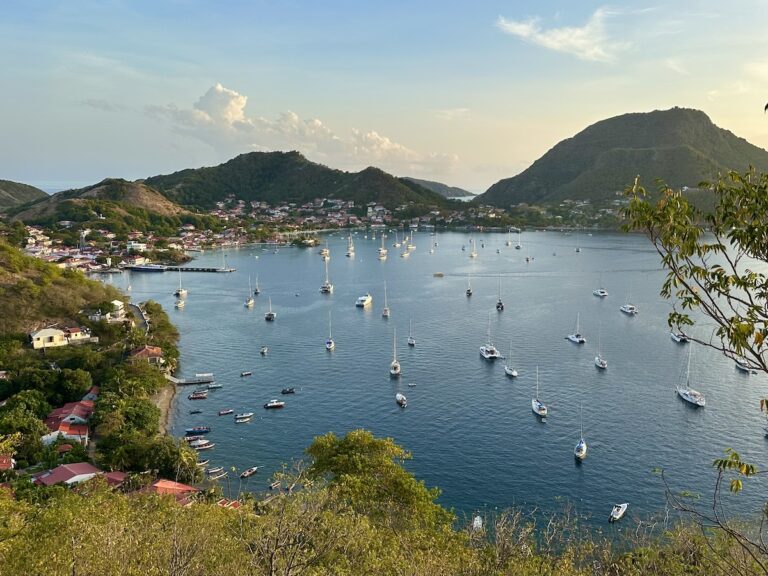
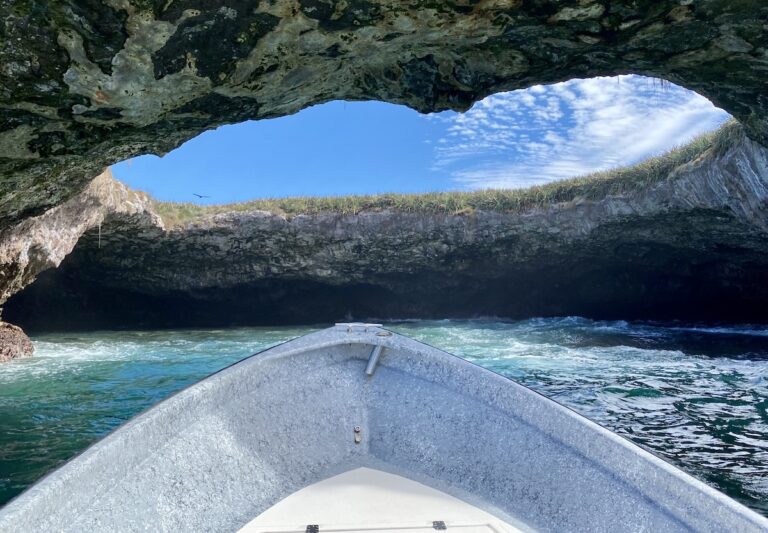
Hi
I enjoyed your info on East Iceland. I’m struggling to find a good itinerary and timeframe. If you reply and I get your email I can then send you my suggested itinerary to see if it works. I look forward to hearing from you.
Kindest regards
Louise (Australia) 🙏
Hi Louise. You can find me at: tara@thebetterbeyond.com